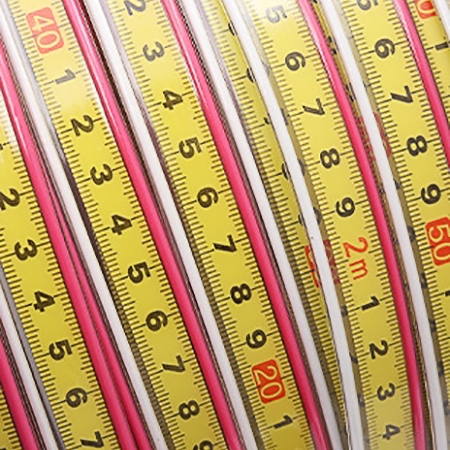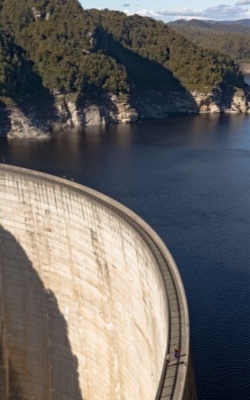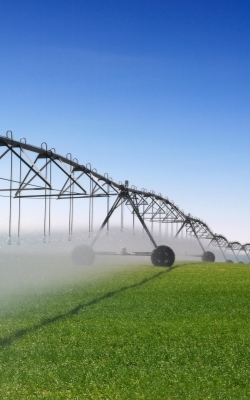A well water level indicator can usually be used to measure the water level in wells, boreholes, and water level pipes. It is particularly suitable for the observation of groundwater levels in hydropower projects or manual inspection of the dam body intrusion line of earth-rock dams.

Powerful Combination, Accurate Detection
- The steel ruler and the wire are combined by plastic technology, and the pulling force is 5 times that of ordinary ones, which can effectively reduce the scratches caused by the friction between the surface of the steel ruler and external objects, keep the scale clear, and extend the service life of the steel ruler.
- Well water level meter uses SUS stainless steel probe with 326L metal probe, anti-corrosion of brine and seawater alkaline water, high detection accuracy and few false alarms, and adds 200 fine threads to make the probe not easy to fall off.
- Water well static level meter equipped with a power-on self-test switch, one-button power-on and direct use, automatic rapid detection, timely detection of potential faults, and enhanced equipment safety.

Solid as A Rock, Easy to Carry
- The rechargeable battery has good battery life and convenient charging, which avoids the trouble of frequent battery replacement of traditional equipment, and does not need to worry about outdoor operations.
- The metal bracket is firm and provides a stable working platform to resist slight vibrations from the outside, wind influence, or slight deformation of the mounting base. It is also fatigue-resistant and not easy to heat up and melt due to friction operation, which reduces the frequency of replacement and maintenance due to bracket damage and saves long-term use costs.
- The well water level gauge is equipped with a portable handle, making it easy to move and carry, reducing the burden of carrying, reducing the risk of collision during transportation, and protecting the precision parts of the instrument.
Applications
The use scenarios of water level meters cover multiple fields such as industry, water conservancy, environmental protection, and energy. Its applications are diversified according to the characteristics of the measuring medium, environmental requirements, and functional requirements.

Dam

Hydroelectric Power Station

Water Tank

Agricultural Irrigation
| Model | SISCO-WLM-SWJ8030 | SISCO-WLM-SWJ8050 | SISCO-WLM-SWJ80100 | SISCO-WLM-SWJ80150 |
| Range | 0~30m | 0~50m | 0~100m | 0~150m |
| Minimum Reading | 1 | |||
| Repeatability Error | ±2.0 | |||
| Operating Voltage | 9V | |||
| Weight | 6.5kg | 10kg | 12kg | 17kg |
Structure Diagram

- Indicator Light
- Peak Indicator
- Switch
Q1: How to Read a Water Level Gauge Correctly?
A1: The key to reading a water level gauge correctly is to first check the device status and environmental conditions to ensure there are no interference factors, then use the corresponding method according to its type (such as glass tube, float type, pressure type or radar/ultrasonic) to read it, usually by looking directly or viewing the display, paying attention to the units and decimal points; at the same time, make sure the device is calibrated, and pay attention to factors such as bubbles and dirt that may affect the accuracy of the reading. Finally, record the reading and do daily cleaning and maintenance to ensure the reliability of the measurement results and the life of the equipment.
Q2: How to Calibrate a Water Level Meter?
A2: The water level meter calibration needs to be completed in a static water body. First, place the probe into a known depth (such as 0cm or standard water level) to adjust the zero point, then calibrate the range by comparing the actual water depth, and set compensation parameters according to the water temperature to eliminate thermal expansion and contraction errors. After completion, record the calibration data and recheck it regularly (such as monthly) to ensure measurement accuracy.
Q3: Common Operational Errors When Using Water Level Meters
A3: Common operational errors when using water level meters include improper installation, neglect of calibration, and neglect of environmental factors. For example, when installing the probe tilted or close to the inlet/outlet, the measured value may be too large or too small, or even fluctuate unstably; failure to perform zero point calibration or neglecting that the medium density does not match the device setting value may cause inaccurate readings.
Tips: Correct Use of Water Level Meter
To use the water level indicator meter correctly, you must first check the status of the device and ensure that it is firmly installed. After turning it on, measure and read the data according to the type of device (contact type needs to be immersed in liquid, non-contact type needs to be aligned with the liquid surface). Avoid collision and angle deviation during operation. After the measurement is completed, clean the probe and equipment in time, calibrate and maintain it regularly, and pay attention to the protection requirements in special environments to ensure accurate measurement and long-term reliable operation of the equipment.
Thank you for buying industrial test and measurement equipment on SISCO.com, all products sold by SISCO and the partner cover a 12 months warranty, effective from the date of receiving the products.
What is covered?
SISCO is responsible for providing free spare parts, and free technical support to assist the customer to repair the defective products until the problem is solved.
What is not covered?
- Product purchased from anyone other than a SISCO store or a SISCO authorized reseller.
- Expendable parts.
- Routine cleaning or normal cosmetic and mechanical wear.
- Damage from misuse, abuse or neglect.
- Damage from use of parts other than SISCO approved.
- Damage from use outside the product’s usage or storage parameters.
- Damage from use of parts not sold by SISCO.
- Damage from modification or incorporation into other products.
- Damage from repair or replacement of warranted parts by a service provider other than a SISCO authorized service provider.
- Damage caused by the application environment not meeting the product usage requirements and the failure to perform preventive maintenance.

